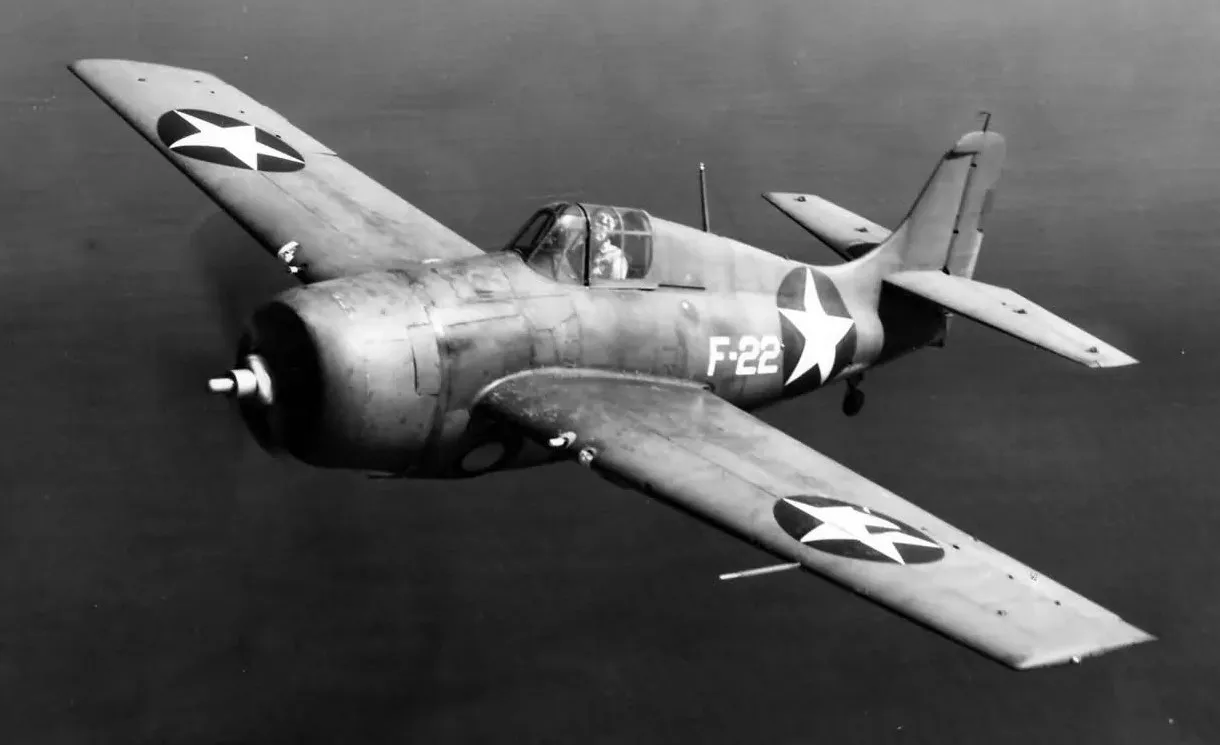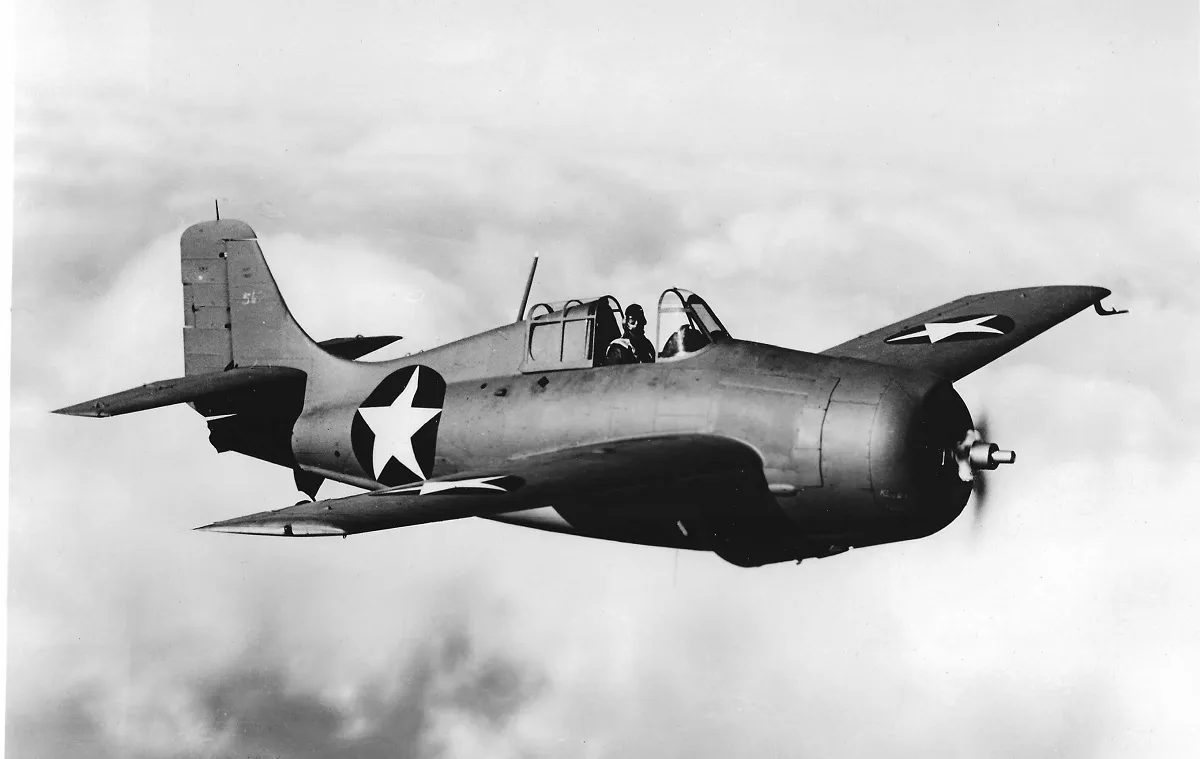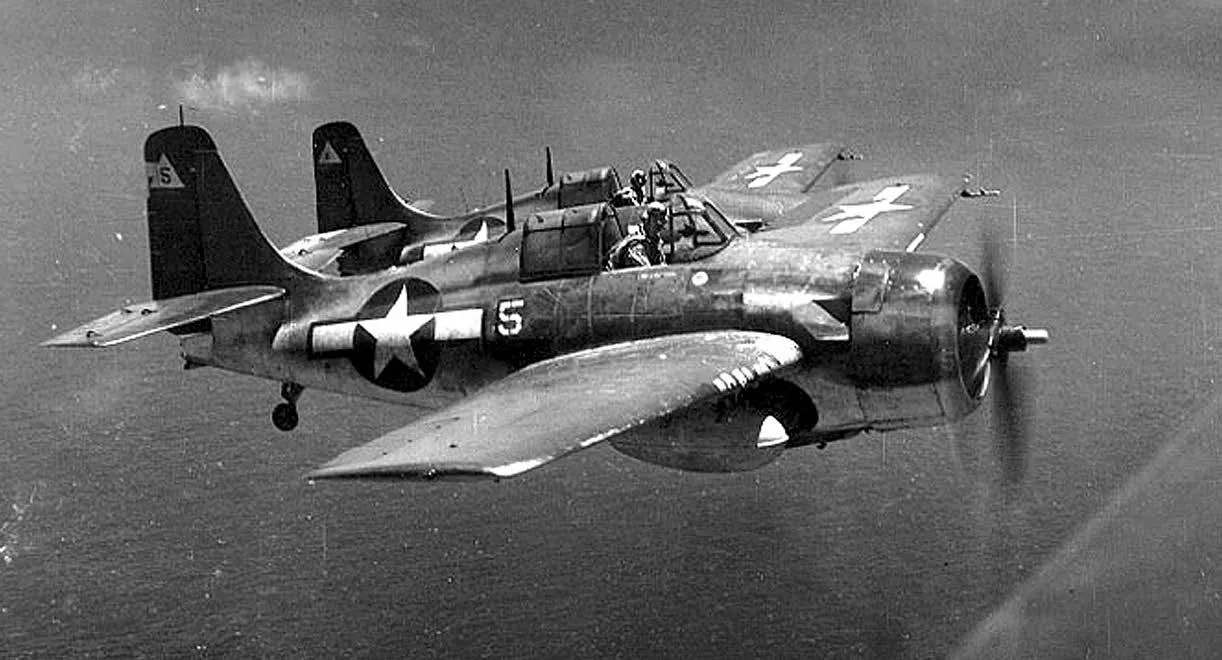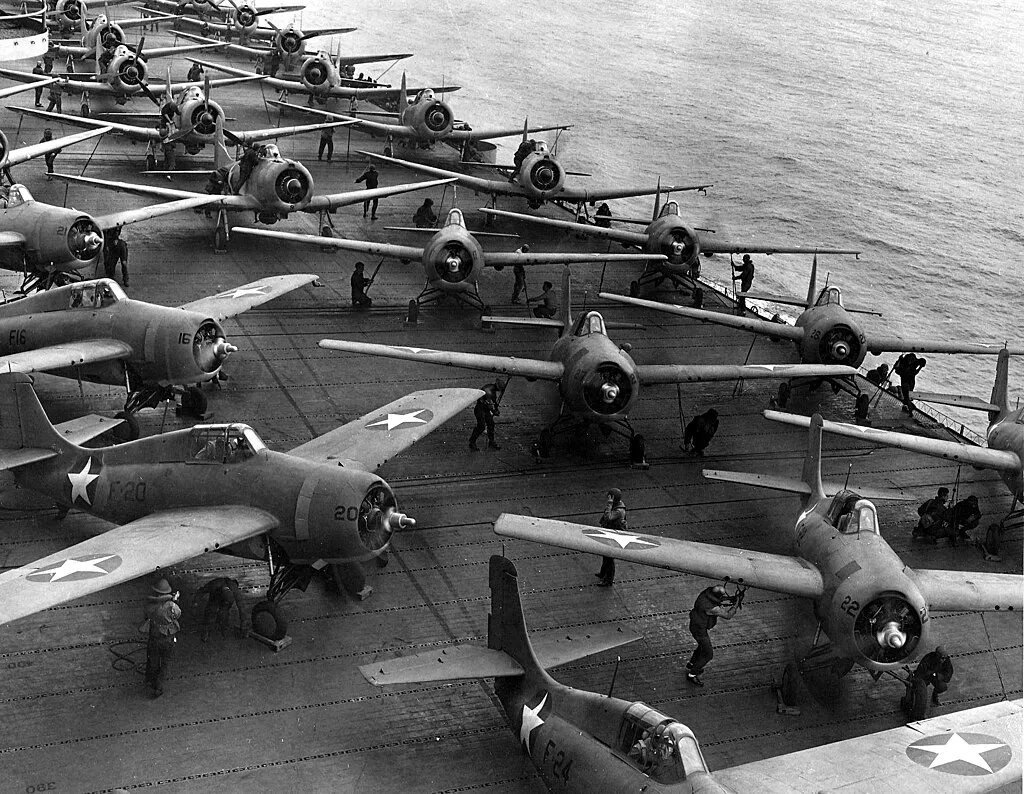Warplanes of the USA: Grumman F4F Wildcat
Grumman F4F Wildcat

(USN Photo)
Grumman FM-2 Wildcat, 17.
The Grumman F4F Wildcat is an American carrier-based fighter aircraft that entered service in 1940 with the United States Navy, and the British Royal Navy where it was initially known as the Martlet. First used by the British in the North Atlantic, the Wildcat was the only effective fighter available to the United States Navy and Marine Corps in the Pacific Theater during the early part of the Second World War. The Wildcat replaced the Brewster Buffalo as aircraft became available.
With a top speed of 318 mph (512 km/h), the Wildcat was outperformed by the faster (331 mph (533 km/h)), more maneuverable, and longer-ranged Mitsubishi A6M Zero. US Navy pilots, including John "Jimmy" Thach, a pioneer of fighter tactics to deal with the A6M Zero, were greatly dissatisfied with the Wildcat's inferior performance against the Zero in the battles of the Coral Sea and Midway. The Wildcat has a claimed air combat kill-to-loss ratio of 5.9:1 in 1942 and 6.9:1 for the entire war. Lessons learned from the Wildcat were later applied to the faster F6F Hellcat. While the Wildcat had better range and maneuverability at low speed, the Hellcat could rely on superior power and high speed performance to outperform the Zero. Wildcat production continued throughout the remainder of the war, with Wildcats serving on escort carriers, where the larger and much heavier Hellcat could not be used. (Wikipedia)

(USN Photo)
Grumman F4F-3.

(USN Photo)
Grumman F4F-4 Wildcats.

(NEAM Ramsay Research Library Photo)
Grumman F4F-4.

(USN Photo)
Crewmen spotting a Grumman F4F-4 Wildcat on the hangar deck of the U.S. Navy escort carrier USS Long Island (AVG-1), 17 June 1942. Several other F4F-4s are present, as are Curtiss SOC-3A Seagull scout-observation planes. All are from Auxiliary Scouting Squadron 1 (VGS-1).
_underway_on_25_May_1943_(80-G-83216).webp)
(USN Photo)
The U.S. Navy escort carrier USS Long Island (ACV-1) underway with a mixed cargo of airplanes and stores on her flight deck, 25 May 1943. The planes include Grumman F4F-4 Wildcat, Douglas SBD Dauntless and Grumman TBF-1 Avenger types. She was repainted in Camouflage Measure 21.

(USN Photo)
USN General Motors FM-2 "Wildcat" fighters from the escort carrier USS White Plains (CVE-66) fly an escort mission, probably during air strikes on Japanese facilities on Rota Island, Marianas, 24 June 1944.

(USN Photo)
Grumman F4F-3 Wildcat (BuNo.).
.webp)
(USN Photo)
Grumman F4F-4 "Wildcat" fighter, of Fighting Squadron Six (VF-6) has its six .50 caliber machine guns tested on the flight deck of USS Enterprise (CV-6), 10 April 1942. Note open gun bays in the plane's wings and markings below the cockpit ("6F9" with no dashes between letters and numerals).

(USN Photo)
Flight deck of USS Hornet (CV-8) on the morning of 4 June 1942. Aircraft are spotted and ready to take off for strike on Japanese Kido Butai during Battle of Midway. F4F-4 Wildcats (from left to right) F-21, F-16, F-20, F-24 and F-22 can be identified in the foreground. This photo shows only 10 Wildcats and according to Lundstrom's The First Team: Pacific Naval Air Combat from Pearl Harbor to Midway (p. 333-334) take-off order these should be all of Mitchell´s escort fighters. Therefore another five unidentified Wildcats should be F-18, F-5, F-9, F-19 and F-13. None of them will return. SBD Dauntlesses in the background should be (according to Lundstrom) from Scounting Eight. According to Clayton Fisher's story [1] the forward SBD in the middle should be Fisher´s Bombing Eight SBDs. Note the old type of helmets on heads of handling-crew.
Survivors
Grumman F4F-3 Wildcat (BuNo. 12260), Lewis Air Legends in San Antonio, Texas. Airworthy.
Grumman F4F-3 Wildcat (BuNo. 3872), National Naval Aviation Museum at Naval Air Station Pensacola, Florida.
.avif)
(Alan Raine Photo)
Grumman F4F-3 Wildcat (BuNo. 4039), displayed unrestored in a simulated underwater diorama at the National Naval Aviation Museum at Naval Air Station Pensacola, Florida.

(Lepeu1999 Photo)
Grumman F4F-3 Wildcat (BuNo. 12296), Pacific Aviation Museum at Ford Island, Hawaii.
Grumman F4F-3 Wildcat (BuNo. 12297), Cradle of Aviation Museum in Garden City, New York. It is on loan from the National Naval Aviation Museum at Naval Air Station Pensacola, Florida.
Grumman F4F-3 Wildcat (BuNo. 12320), Chicago O'Hare International Airport in Chicago, Illinois as a memorial to Navy Cross and Medal of Honor recipient and airport namesake, LCDR Edward O'Hare. It is on loan from the National Naval Aviation Museum at Naval Air Station Pensacola, Florida.
Grumman F4F-3 Wildcat (BuNo. 12290), being restored for static display at the USS Midway Museum in San Diego, California.
Grumman F4F-3A Wildcat (BuNo. 3956), Patriots Point Naval Museum in Mount Pleasant, South Carolina.
.avif)
(Alan Raine Photo)
Grumman F4F-3A Wildcat (BuNo. 3969), National Naval Aviation Museum at Naval Air Station Pensacola, Florida.
Grumman F4F-4 Wildcat (BuNo. 11828), San Diego Aerospace Museum in San Diego, California. It is on loan from the National Naval Aviation Museum at Naval Air Station Pensacola, Florida.
Grumman F4F-4 Wildcat (BuNo. 12114), National Museum of the Marine Corps in Triangle, Virginia.
Grumman's Wildcat production ceased in early 1943 to make way for the newer F6F Hellcat, but General Motors continued producing Wildcats for both the U.S. Navy and Fleet Air Arm.
Grumman FM-1 Wildcat (BuNo. 14994), (F4F-4), Valiant Air Command Warbird Museum at Space Coast Regional Airport in Titusville, Florida. It is on loan from the National Naval Aviation Museum at Naval Air Station Pensacola, Florida.
Grumman FM-1 Wildcat (BuNo. 15392), National Air and Space Museum in Washington, D.C.
General Motors production of the Wildcat later switched to the improved FM-2 (based on Grumman's XF4F-8 prototype, informally known as the "Wilder Wildcat") optimized for small-carrier operations, with a more powerful engine, and a taller tail to cope with the increased torque.
.avif)
(kitmasterbloke Photo)
Grumman FM-2 Wildcat (BuNo. 16089), National Naval Aviation Museum at Naval Air Station Pensacola, Florida.
.avif)
(Aaron Headly Photo)
Grumman FM-2 Wildcat (BuNo. 16161), being restored to airworthy status, by the Pima Air & Space Museum, Tucson, Arizona. It crashed in Lake Michigan on 12 April 1945, and is on loan from Military Aircraft Restoration Corporation in Anaheim, California.
Grumman FM-2 Wildcat (BuNo. 16203), Michael Gillian in Downers Grove, Illinois. Airworthy.
Grumman FM-2 Wildcat (BuNo. 16278), Flying Leatherneck Aviation Museum at Marine Corps Air Station Miramar, San Diego, California.
.avif)
(Tomas Del Coro Photo)
Grumman FM-2 Wildcat (BuNo. 47030), Military Aviation Museum in Virginia Beach, Virginia. Airworthy.
Grumman FM-2 Wildcat (BuNo. 47160), FM-2 LCC in Lewes, Delaware. Airworthy.
Grumman FM-2 Wildcat (BuNo. 55052), being restored for static display at the USS Hornet (CV-12) in Alameda, California.
Gruman FM-2 Wildcat (BuNo. 55627), Palm Springs Air Museum in Palm Springs, California. Airworthy.
Grumman FM-2 Wildcat (BuNo. 57039), being restored for static display at the Glenview Hangar One Museum at the former Naval Air Station Glenview, Glenview, Cook County, Illinois. While conducting training on 28 December 1944, the FM2 Wildcat malfunctioned and rolled off the deck of the training aircraft carrier USS Sable. The pilot, ENS William Forbes, escaped from the aircraft before it sank into Lake Michigan. In early December 2012, the aircraft was moved 45 miles under the water to a safe harbor in Waukegan, Ilinois. The Wildcat fighter was lifted from the water on Friday 7 Dec 2012.
Grumman FM-2 Wildcat (BuNo. 74120), New England Air Museum, Windsor Locks, Connecticut.
Grumman FM-2 Wildcat (BuNo. 74161), National Museum of the Pacific War in Fredricksburg, Texas. It is on loan from the National Naval Aviation Museum at Naval Air Station Pensacola, Florida.

(Articseahorse Photo)
Grumman FM-2 Wildcat (BuNo. 74512), Museum of Flight in Seattle, Washington.
Grumman FM-2 Wildcat (BuNo. 74560), Comanche Warbirds Inc. in Houston, Texas. Airworthy.

(Alan Wilson Photo)
Grumman FM-2 Wildcat (BuNo. 86564), Yanks Air Museum in Chino, California. Airworthy.
_(48334213757).avif)
(Gary Todd Photo)
Grumman FM-2 Wildcat (BuNo. 86572), Thomas Camp in Sausalito, California. Airworthy.
.avif)
(Michael Barera Photo)
Grumman FM-2 Wildcat (BuNo. 86581), Air Zoo in Kalamazoo, Michigan.
Grumman FM-2 Wildcat (BuNo. 86680), Collings Foundation in Stow, Massachusetts. This Wildcat is unique in having a passenger cabin able to carry 4 passengers. Airworthy.
.avif)
(Valder137 Photo)
Grumman FM-2 Wildcat (BuNo. 86741), Fantasy of Flight in Polk City, Florida. Airworthy.
Grumman FM-2 Wildcat (BuNo. 86746), Frasca Air Museum in Champaign, Illinois. Airworthy.
_(31677183588).avif)
(kitmasterbloke Photo)
Grumman FM-2 Wildcat (BuNo. 86747), National Naval Aviation Museum at Naval Air Station Pensacola, Florida.
.avif)
(Valder137 Photo)
Grumman FM-2 Wildcat (BuNo. 86754), Erickson Aircraft Collection in Madras, Oregon. Airworthy.
Grumman FM-2 Wildcat (BuNo. 86773), being restored to airworthy status by Bruce Roberts in New London, Pennsylvania.
_(45818262641).avif)
(Aaron Headly Photo)
Grumman FM-2 Wildcat (BuNo. 86774), N774FM LLC in Granite Falls, Minnesota. Airworthy.
Grumman FM-2 Wildcat (BuNo. 86777), Texas Flying Legends Museum in Houston, Texas. Airworthy.
Grumman FM-2 Wildcat (BuNo. 86819), Commemorative Air Force (Colonel Carter Teeters) in San Diego, California. Airworthy.

(Balon Greyjoy Photo)
Grumman FM-2 Wildcat (BuNo. 86956), Reg. No. N18P, Cavanaugh Flight Museum in Addison, Texas. Airworthy.

(IWM Photo, A 24529)
A Fleet Air Arm Grumman Wildcat of No 846 Squadron Fleet Air Arm based at Eglington, Northern Ireland, in flight over the coast. The aircraft displays the stripes carried by aircraft of the Allied Expeditionary Force during the Normandy landings.
_(12258871324).avif)
(Alan Wilson Photo)
Grumman FM-2 Wildcat (BuNo. 86690), Reg. No. N49JC, now with the Shuttleworth Collection in the UK.
_FM-2_Wildcat_AN1785353.avif)
(Kral Michal Photo)
Grumman FM-2 Wildcat (BuNo. 86711), Imperial War Museum, Duxford, UK.





